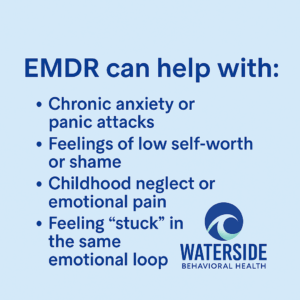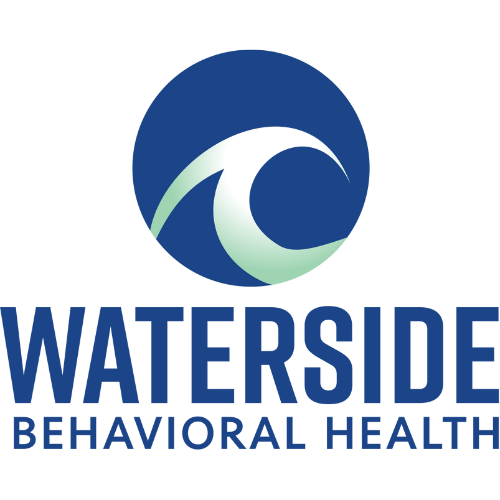You might’ve heard about EMDR therapy in a podcast, on TikTok, or maybe from a friend who swears it changed their life. But when you look it up, it sounds… confusing at best. Eye movement? Trauma healing? Do you just stare at a light and cry?
As a counselor, I’ve heard it all—and I get it. The science sounds strange, but the results are real. If you’re a parent trying to understand new therapy options, especially if you’re just starting to explore what mental health treatment even is, here’s a breakdown of EMDR in everyday language.
Whether you’re doing the research for your child or for yourself, this blog is here to walk you through what EMDR really is, how it works, and why it might be worth trying—even if you’re just sober curious and wondering what else could help.
What Does EMDR Actually Stand For?
Let’s start with the basics. EMDR stands for Eye Movement Desensitization and Reprocessing. Yes, it’s a mouthful. But the core idea is simple: it’s a way to help your brain “unstick” painful memories or stressful patterns and move them into a place where they don’t control you anymore.
EMDR is used to treat trauma, anxiety, panic attacks, low self-esteem, and more. It’s not just for people who have been through war or extreme abuse. If your nervous system still reacts like you’re in danger—even when you’re not—EMDR might help.
The Brain’s Filing Cabinet: How Trauma Gets Stuck
Think of your brain like a giant filing cabinet.
Normally, when something stressful happens—like a tough conversation or a scary situation—your brain processes it, files it away, and moves on.
But when something really overwhelming happens? The brain gets jammed. Instead of being processed, the memory gets stored raw—full of emotion, body tension, and unspoken thoughts. It doesn’t get filed away. It just floats there, waiting to be triggered again.
That’s why you might feel panicked when someone raises their voice—even if you know you’re not in danger. Or why your teen suddenly shuts down every time someone says the word “school.”
EMDR helps your brain go back, finish the job, and file that memory in a calmer, more complete way.
What Happens in an EMDR Session?
Here’s the part that makes EMDR unique: instead of just talking through trauma, you’ll use something called bilateral stimulation. That usually means moving your eyes back and forth, tapping alternately on your hands, or listening to sounds in each ear.
While that’s happening, your therapist will guide you to gently focus on a difficult memory or feeling. Not to relive it—but to notice it, hold it lightly, and let your brain start to reprocess it.
You don’t have to go into every detail. You don’t have to explain your entire history. You don’t even have to cry. The healing happens deep inside the brain, quietly and safely, while you stay fully present.
Why Eye Movements Help More Than You’d Think
It’s wild, right? Why would eye movements make a difference?
Here’s one working theory: during REM sleep (when your eyes naturally move back and forth), your brain processes emotions and stores memories. EMDR mimics that brain activity—but while you’re awake and supported.
It’s like giving your brain another chance to clean up the mess that trauma left behind. And you’re not doing it alone—you’re doing it with a therapist who’s trained to keep you grounded and safe the whole time.
EMDR Works for More Than Just Trauma
You don’t need a major “trauma story” to benefit from EMDR. It’s not just for car accidents or abuse survivors. It’s for anyone whose brain is reacting like something is still wrong—even if the danger has passed.
EMDR can help with:
- Chronic anxiety or panic attacks
- Feelings of low self-worth or shame
- Childhood neglect or emotional pain
- Trouble sleeping or relaxing
- Feeling “stuck” in the same emotional loop
It’s especially helpful for people who know they’re reacting more intensely than they want to—but can’t seem to stop it.

Is EMDR Backed by Research?
Absolutely. EMDR has been around for over 30 years and is recommended by:
- The World Health Organization
- The American Psychiatric Association
- The VA (for veterans with PTSD)
Some studies show it works faster than traditional talk therapy for trauma. But more importantly, people often say the memory feels “less sharp” or “less controlling” afterward.
One client put it perfectly:
“I still remember what happened. But it’s like the emotional volume got turned way down.”
Who Can Benefit from EMDR?
If you’re a parent, here’s where it gets real: EMDR isn’t just something your kid might need—it’s something you might benefit from, too.
We carry so much: old pain, fear, shame, second-guessing. You don’t need to meet some crisis threshold to get help.
If you’re noticing that your past still pokes through—in how you parent, how you react, or how you cope—EMDR might be a gentle way to find your footing again.
Looking for EMDR in Plymouth County, MA?
At Waterside Behavioral Health, our therapists are trained in EMDR and ready to meet you exactly where you are. We serve families and individuals across Plymouth County and Bristol County with trauma-informed care that doesn’t push or pressure—it invites healing.
You don’t have to be in crisis to benefit. You just have to be curious about what life might feel like with less stress buzzing in your body.
Frequently Asked Questions About EMDR
Do I have to talk about everything that happened to me?
No. EMDR doesn’t require you to say every detail out loud. In fact, many sessions focus on what you’re noticing inside, not on re-telling the story.
Is EMDR safe for kids or teens?
Yes—when done by a licensed and trained therapist, EMDR can be very effective for children and teens. It’s especially helpful for anxiety, trauma, and school-related stress.
How long does EMDR take to work?
It varies. Some people feel relief after just a few sessions. Others may need longer to build trust and move through memories at their own pace. EMDR is not one-size-fits-all—but it is designed to respect your timing.
What if I don’t remember a specific trauma?
That’s okay. EMDR can still help with body-based anxiety, negative self-beliefs, or fuzzy emotional memories. Your brain knows what it’s holding—even if you don’t have all the words yet.
Can EMDR help if I’m not sure I’ve had “real trauma”?
Yes. Emotional wounds don’t need a headline to matter. If something still lives in your body—and affects your life—then it’s real enough to heal.
Ready to Try Something New?
Whether you’re exploring EMDR for yourself or trying to support someone you love, know this: curiosity is enough. You don’t need a diagnosis, a crisis, or the perfect words. Just a willingness to see what else is possible.
Call 774-619-7750 or Contact Us to learn more about EMDR therapy in Plymouth County, MA.




